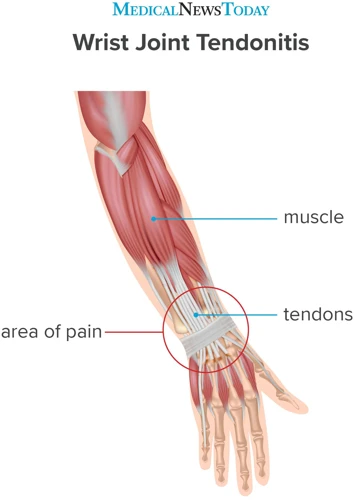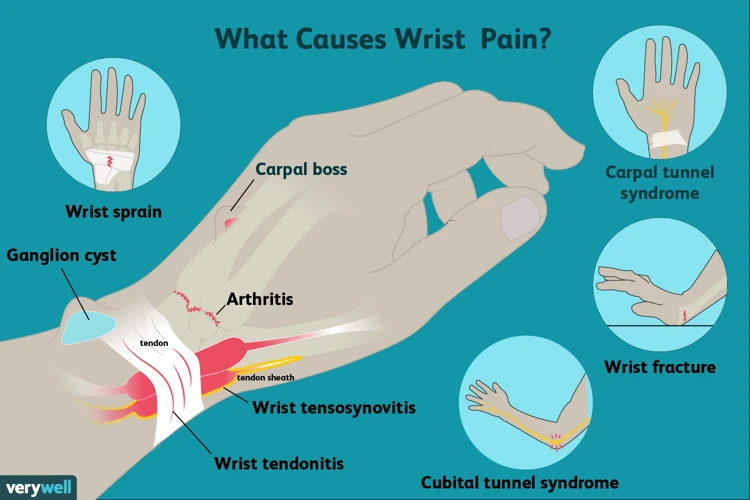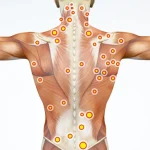Struggling with wrist pain or tendonitis? A simple wrist massage might be exactly what you need. Whether your discomfort comes from typing, lifting, or repetitive motion, targeted massage can ease tension, improve circulation, and reduce inflammation. In this guide, we’ll show you how to safely perform a wrist massage for tendonitis relief — including step-by-step techniques, helpful tools, and when to seek professional help. With the right approach, wrist massage can be a powerful and natural way to reduce pain and support your recovery.
Table of Contents
What is Wrist Tendonitis?

Wrist tendonitis is an inflammatory condition that causes pain and swelling in the wrist and forearm. It is caused by repetitive movements and overuse of the tendons in the wrist and forearm. The condition can become chronic if not treated properly. Symptoms may include pain, tenderness, stiffness, and difficulty using the wrist and hand.
How to Massage Tendonitis: Massaging the area can help reduce the pain and swelling associated with wrist tendonitis. Light massage with a soft brush or cloth can help to increase circulation and reduce swelling. Massage can also help loosen up tight muscles and reduce inflammation. Applying gentle pressure to the affected area with circular motions can help to relieve pain and stiffness. It is also important to avoid aggravating any existing muscle tension or inflammation.
Symptoms of Wrist Tendonitis

- Pain: Pain is usually felt at the base of the thumb, but can also spread to the forearm and elbow.
- Swelling: Swelling at the base of the thumb is often the first symptom to appear.
- Tenderness: Affected area is often tender to the touch and may even feel warm.
- Stiffness: Joints may become stiff and movement may become difficult due to inflammation.
- Weakness: Pain and inflammation may cause weakness in the affected area.
The symptoms of wrist tendonitis can range from mild to severe and can worsen over time if left untreated. It’s important to seek medical attention if you experience any of the above symptoms, as they can be indicators of a more serious issue.
Fortunately, massage therapy can help alleviate the symptoms of wrist tendonitis. Massage can help reduce inflammation, increase range of motion, and reduce pain. Massaging the affected area can also help loosen tightness, allowing for greater freedom of movement and increased flexibility.
Causes and Risk Factors of Wrist Tendonitis

Repeated and forceful movements of the wrist can cause inflammation of the tendons and lead to wrist tendonitis. This condition is more likely to occur in individuals who are involved in activities that require repetitive movements of the wrist. Examples include playing sports such as tennis, golf, and baseball; typing on a computer keyboard; and performing manual labor.
Other potential causes and risk factors of wrist tendonitis include:
- Injury to the wrist
- Bone spurs
- Arthritis
- Tight muscles or lack of flexibility in the wrist and forearm
- Poor posture
- Improper technique or form when performing repetitive wrist movements
Individuals who are over the age of 40 are more likely to develop wrist tendonitis due to age-related wear and tear of the tendons.
How to Perform A Wrist Massage for Tendonitis

✅ What You’ll Need:
- A bit of unscented lotion or massage oil (optional, to reduce friction)
- A bit of unscented lotion or massage oil (optional, to reduce friction)
- A comfortable surface to rest your arm
- Optional: a massage ball or thumb roller for added pressure
👣 Step-by-Step Wrist Massage Technique
- Warm Up the Area
Rub your hands together to create warmth, then gently stroke the forearm and wrist to stimulate blood flow (1–2 minutes). - Use Gentle Circular Motions
With your opposite thumb, make small, gentle circles around the wrist joint, focusing on sore or tight spots. - Work the Tendons Along the Forearm
Trace the tendons from your elbow down to the wrist with firm but gentle pressure using your thumb or fingers. This helps release tension in the connected muscles. - Apply Cross-Fiber Friction
Use your thumb or fingertips to apply side-to-side (horizontal) strokes across the inflamed tendon — this can help realign scar tissue and reduce stiffness. - Stretch and Relax
Finish with light wrist stretches (flexion and extension) to encourage mobility and calm the tissue.
⚠️ Important Tips:
- Keep pressure gentle, especially if you’re inflamed
- Avoid massaging directly over sharp or acute pain
- Massage for 5–10 minutes max, 1–2 times daily
- Always follow up with rest or cold therapy if swelling is present
Wrist Massage Alternatives
Friction Wrist Massage

Friction massage is one of the most effective wrist massage techniques for relieving tendonitis. This method involves rubbing the affected area in a circular motion using deep, targeted pressure. As part of a wrist massage routine, friction massage can help break down adhesions in the muscles and tendons, improve circulation, and reduce inflammation.
To perform a friction wrist massage, start by applying firm pressure to the sore area and use small circular motions. Gradually increase the pressure as tolerated, maintaining consistent motion for about one minute. For best results, this wrist massage technique should be repeated two to three times per day, especially during flare-ups or after repetitive use.
Trigger Point Wrist Massage

Trigger Point Massage is a focused technique that applies concentrated pressure to specific points in the body — often areas of heightened sensitivity or muscle tension. When incorporated as part of a wrist massage routine, it can be especially helpful in addressing chronic tension and inflammation related to wrist tendonitis.
This technique is effective for relieving pain and tightness in muscles and surrounding soft tissue. As part of a therapeutic wrist massage, trigger point work can improve range of motion, reduce inflammation, and support tendon healing.
While commonly used for neck and shoulder pain, back pain, and fibromyalgia, trigger point massage can also target tension around the forearm and wrist — especially helpful for overuse injuries like tendonitis or carpal tunnel syndrome.
The pressure is usually applied using fingers, thumbs, elbows, or tools like massage balls and rollers. When targeting wrist pain, tools such as a thumb roller or lacrosse ball can help apply precise, steady pressure without straining your hands.
For best results, it’s important to work with a trained massage therapist — especially when dealing with tendonitis — to ensure trigger point massage is applied safely and effectively.
Benefits of Massage for Wrist Tendonitis

Massage is an effective way to treat wrist tendonitis and can help reduce pain and discomfort. It can also help improve flexibility and range of motion, as well as reduce inflammation. Massage can be used to target specific areas of the wrist and forearm, which can allow for more targeted treatment of the problem area. Massage can also help improve circulation, which can help reduce swelling and inflammation.
| Benefit | Description |
|---|---|
| Reduce Pain and Discomfort | Massage can help reduce pain and discomfort from wrist tendonitis. |
| Increase Flexibility and Range of Motion | Massage can help improve flexibility and range of motion in the wrist and forearm. |
| Reduce Inflammation | Massage can help reduce inflammation, which can help reduce swelling and discomfort. |
| Target Specific Areas | Massage can be used to target specific areas of the wrist and forearm, allowing for more targeted treatment. |
| Improve Circulation | Massage can help improve circulation, which can help reduce swelling and inflammation. |
Massage can be a great way to treat wrist tendonitis and can provide many benefits, including reducing pain and discomfort, increasing flexibility and range of motion, reducing inflammation, targeting specific areas, and improving circulation. By utilizing these techniques, you can help unlock relief from your wrist tendonitis.
When to See a Doctor for Wrist Tendonitis

Tendonitis of the wrist can be a very painful and debilitating condition. If not treated properly, it can worsen over time and cause more significant damage. If you are experiencing any of the following symptoms, it’s important to seek medical advice:
- Severe pain in the wrist
- Swelling of the wrist
- Redness of the wrist
- Difficulty moving the wrist
- Shooting or throbbing pain
- Numbness or tingling in the wrist
If you are experiencing any of these symptoms, it’s important to seek medical advice and get a diagnosis. Your doctor may recommend rest, medication, physical therapy, or even surgery depending on the severity of your condition. In some cases, massage therapy can be beneficial in treating wrist tendonitis, but it’s important to consult your doctor before trying any massage techniques to ensure you are not causing further harm.
Complications of Wrist Tendonitis
Wrist tendonitis can develop into a chronic condition if left untreated. Symptoms may include persistent pain and tenderness in the wrist, difficulty moving the wrist, decreased grip strength, and swelling around the affected area. If complications occur, they can include:
| Complication | Description |
|---|---|
| Carpal tunnel syndrome | Carpal tunnel syndrome is caused by swelling around the median nerve as it passes through the wrist. Symptoms may include pain, tingling, numbness, and weakness. |
| De Quervain’s disease | De Quervain’s disease is a condition that affects the tendons in the thumb. Symptoms may include pain, swelling, and difficulty moving the thumb. |
| Trigger finger | Trigger finger is a condition in which the finger is stuck in a bent position and cannot be straightened. Symptoms may include pain, stiffness, and a clicking or popping sound when the finger is moved. |
If you are experiencing any of these complications as a result of wrist tendonitis, it is important to seek medical attention. Massage therapy can help to reduce pain and improve mobility, but it is important to follow your doctor’s instructions for treatment.
Frequently Asked Questions
How Often Should I Massage My Wrist For Tendonitis?
The frequency of wrist massage depends on the severity of the tendonitis and the individual’s ability to tolerate pressure. In general, it’s recommended to perform a wrist massage twice a day — once in the morning and again in the evening. Each session should last 5–10 minutes and include gentle, soothing strokes focused on the affected area. Be careful not to press too hard, and always stop if you feel pain or discomfort. If wrist massage becomes too painful, reduce the intensity or frequency until symptoms improve.
What Should I Do If I Experience Pain While Massaging My Wrist?
If you experience pain while massaging your wrist, stop immediately and apply ice to the affected area. Once the pain has subsided, reduce the pressure you are applying and slowly increase it again. If the pain persists, it is best to consult your doctor.
What other treatments may be helpful for wrist tendonitis in addition to massage?
- Exercises: Gentle stretches and strength-building exercises can help reduce inflammation and improve range of motion.
- Rest: Taking breaks from activities that aggravate wrist tendonitis can help reduce inflammation and pain.
- Splints: Wearing a splint at night can help keep the wrist in a neutral position while sleeping to reduce pain.
- Medication: Over-the-counter medications such as ibuprofen can help reduce swelling and pain.
- Injections: Steroid injections may be recommended to reduce inflammation and pain.
Conclusion
Massage therapy for wrist tendonitis can help to reduce inflammation and pain, improve range of motion and flexibility, and promote healing. Applying these simple techniques can make a world of difference in relieving the pain and discomfort associated with wrist tendonitis. It is important to talk to your doctor before beginning any type of massage therapy to ensure it is safe and suitable for your individual needs.
📖Explore More:
👉 Discover the Amazing Benefits of Hand and Arm Massage
👉 How to Massage a Ganglion Cyst for Pain Relief & Healing
References
- Massage Therapy for the Treatment of Wrist Tendonitis: A Systematic Review
- Tendonitis: Diagnosis and treatment
- Stretching exercises
⚠️ Disclaimer:
This article is for informational purposes only and does not constitute medical advice. Always consult with a licensed healthcare provider or certified massage therapist before beginning any new treatment, especially if you have pre-existing health conditions or concerns.













